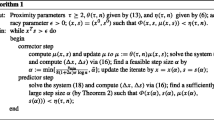Abstract
AP *-geometric linear complementarity problem (P *GP) as a generalization of the monotone geometric linear complementarity problem is introduced. In particular, it contains the monotone standard linear complementarity problem and the horizontal linear complementarity problem. Linear and quadratic programming problems can be expressed in a “natural” way (i.e., without any change of variables) asP *GP. It is shown that the algorithm of Mizunoet al. [6] can be extended to solve theP *GP. The extended algorithm is globally convergent and its computational complexity depends on the quality of the starting points. The algorithm is quadratically convergent for problems having a strictly complementary solution.
Similar content being viewed by others

References
R. W. Cottle, J.-S. Pang, and R. E. Stone. The Linear Complementarity Problem. Academic Press, Boston, MA, 1992.
R. W. Cottle, J.-S. Pang, and V. Venkateswaran. Sufficient matrices and the linear complementarity problem. Linear Algebra and Its Applications, 114/115:231–249, 1989.
O. Güler. Generalized linear complementarity problems. Mathematics of Operations Research, 20:441–448, 1995.
J. Ji, F. A. Porta, and R. Sheng. A predictor-corrector method for solving theP *-matrix LCP from infeasible starting points. Reports on Computational Mathematics 55, Department of Mathematics, University of Iowa, Iowa City, IA, June 1994.
M. Kojima, N. Megiddo, T. Noma, and A. Yoshise. A unified approach to interior point algorithms for linear complementarity problems. Lecture Notes in Computer Science, Vol. 538, Springer-Verlag, Berlin, 1991.
S. Mizuno, F. Jarre, and J. Stoer. A unifier approach to infeasible-interior-point algorithms via geometrical linear complementarity problems. Preprint No. 213. Mathematische Institute der Universität Würzburg, Würzburg, April 1994.
F. A. Porta. AnO (nL) infeasible-interior-point algorithm for LCP with quadratic convergence. Reports on Computational Mathematics 50, Department of Mathematics, University of Iowa, Iowa City, IA, January 1994.
F. A. Porta and R. Sheng. A modifiedO(nL) infeasible-interior-point algorithm for LCP with quadratic convergence. Reports on Computational Mathematics 54, Department of Mathematics, University of Iowa, Iowa City, IA, April 1994.
F. A. Porta and R. Sheng. Predictor-corrector algorithms for solvingP * (κ)-matrix LCP from arbitrary positive starting points. Reports on Computational Mathematics 58, Department of Mathematics, University of Iowa, Iowa City, IA, August 1994.
J. Stoer. The complexity of an infeasible interior-point path-following method for the solution of linear programs. Optimization Methods and Software, 3:1–12, 1994.
H. Väliaho,P *-matrices are just sufficient. Linear Algebra and Its Applications, 239:103–108, 1996.
Author information
Authors and Affiliations
Additional information
The work of F. A. Potra was supported in part by NSF Grant DMS 9305760
Rights and permissions
About this article
Cite this article
Anitescu, M., Lesaja, G. & Potra, F.A. An infeasible-interior-point predictor-corrector algorithm for theP *-geometric LCP. Appl Math Optim 36, 203–228 (1997). https://doi.org/10.1007/BF02683343
Accepted:
Issue Date:
DOI: https://doi.org/10.1007/BF02683343
Key Words
- P *-matrix
- Linear complementarity problems
- Predictor-corrector
- Infeasible-interior-point algorithm
- Polynomiality
- Quadratic convergence



